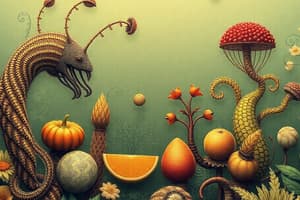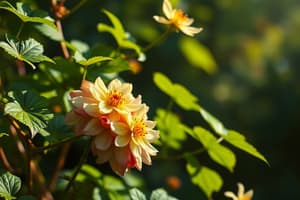Podcast
Questions and Answers
What do plants use to convert sunlight energy into chemical energy?
What do plants use to convert sunlight energy into chemical energy?
- Chlorophyll (correct)
- Carbon dioxide
- Water
- Minerals
Plants can produce their own food without sunlight.
Plants can produce their own food without sunlight.
False (B)
What three essential components do plants get from their environment?
What three essential components do plants get from their environment?
Water, carbon dioxide, and necessary minerals
Plants absorb sunlight energy through ______ in their chloroplast.
Plants absorb sunlight energy through ______ in their chloroplast.
Match the following terms with their associated functions:
Match the following terms with their associated functions:
What type of organism does Euglena become if it loses its chloroplast?
What type of organism does Euglena become if it loses its chloroplast?
Euglena relies solely on autotrophic methods to obtain food under all conditions.
Euglena relies solely on autotrophic methods to obtain food under all conditions.
In the absence of light, how does Euglena obtain its food?
In the absence of light, how does Euglena obtain its food?
Euglena can lose its chloroplast and live as a _______ organism when deprived of light.
Euglena can lose its chloroplast and live as a _______ organism when deprived of light.
Match the following terms with their descriptions:
Match the following terms with their descriptions:
What is a stack of thylakoids called?
What is a stack of thylakoids called?
Thylakoids are the primary site for photosynthesis in plant cells.
Thylakoids are the primary site for photosynthesis in plant cells.
What do thylakoids contain that is crucial for the photosynthesis process?
What do thylakoids contain that is crucial for the photosynthesis process?
Each ______ is a flattened sac that makes up the granum.
Each ______ is a flattened sac that makes up the granum.
Match the following terms with their correct definitions:
Match the following terms with their correct definitions:
Which two elements are essential for the activation of enzymes in photosynthesis?
Which two elements are essential for the activation of enzymes in photosynthesis?
Soil ventilation has no effect on photosynthesis.
Soil ventilation has no effect on photosynthesis.
What role do manganese and magnesium play in photosynthesis?
What role do manganese and magnesium play in photosynthesis?
Manganese and magnesium are important for the activation of __________ in photosynthesis.
Manganese and magnesium are important for the activation of __________ in photosynthesis.
What is the primary function of xylem vessels in plants?
What is the primary function of xylem vessels in plants?
Carbon dioxide is absorbed by the chloroplasts directly.
Carbon dioxide is absorbed by the chloroplasts directly.
What are the two main parts of a chloroplast?
What are the two main parts of a chloroplast?
Water is absorbed by the roots and transported by _____ vessels.
Water is absorbed by the roots and transported by _____ vessels.
Match the following plant structures with their functions:
Match the following plant structures with their functions:
What is the primary function of the rodent mouthparts in grasshoppers?
What is the primary function of the rodent mouthparts in grasshoppers?
Rodent mouthparts in grasshoppers are used primarily for sucking food.
Rodent mouthparts in grasshoppers are used primarily for sucking food.
What type of mouthparts do grasshoppers have?
What type of mouthparts do grasshoppers have?
The jaws of grasshoppers are involved in __________ food.
The jaws of grasshoppers are involved in __________ food.
Match the following features of grasshopper mouthparts with their functions:
Match the following features of grasshopper mouthparts with their functions:
Flashcards
Photosynthesis
Photosynthesis
The process by which plants use sunlight, water, and carbon dioxide to create their own food (glucose).
Chlorophyll
Chlorophyll
A green pigment found in plants that absorbs sunlight energy for photosynthesis.
Chloroplasts
Chloroplasts
The tiny organelles within plant cells that contain chlorophyll and are the site of photosynthesis.
Absorption
Absorption
Signup and view all the flashcards
Chemical Energy
Chemical Energy
Signup and view all the flashcards
Euglena's heterotrophic nutrition
Euglena's heterotrophic nutrition
Signup and view all the flashcards
Euglena's autotrophic nutrition
Euglena's autotrophic nutrition
Signup and view all the flashcards
Chloroplast loss in Euglena
Chloroplast loss in Euglena
Signup and view all the flashcards
Euglena's nutritional flexibility
Euglena's nutritional flexibility
Signup and view all the flashcards
Euglena becoming heterotrophic
Euglena becoming heterotrophic
Signup and view all the flashcards
Granum
Granum
Signup and view all the flashcards
Thylakoid
Thylakoid
Signup and view all the flashcards
Photosystem
Photosystem
Signup and view all the flashcards
Role of Manganese and Magnesium in Photosynthesis
Role of Manganese and Magnesium in Photosynthesis
Signup and view all the flashcards
Soil Ventilation
Soil Ventilation
Signup and view all the flashcards
How Soil Ventilation Impacts Photosynthesis
How Soil Ventilation Impacts Photosynthesis
Signup and view all the flashcards
Impact of Poor Soil Ventilation on Photosynthesis
Impact of Poor Soil Ventilation on Photosynthesis
Signup and view all the flashcards
Maintaining Good Soil Ventilation for Photosynthesis
Maintaining Good Soil Ventilation for Photosynthesis
Signup and view all the flashcards
Water Transport in Plants
Water Transport in Plants
Signup and view all the flashcards
Stoma
Stoma
Signup and view all the flashcards
Stroma
Stroma
Signup and view all the flashcards
Rodent mouth parts in Grasshoppers
Rodent mouth parts in Grasshoppers
Signup and view all the flashcards
Jaws in Grasshoppers
Jaws in Grasshoppers
Signup and view all the flashcards
Function of Grasshopper mouthparts
Function of Grasshopper mouthparts
Signup and view all the flashcards
Grasshopper feeding habits
Grasshopper feeding habits
Signup and view all the flashcards
Invertebrate mouthpart adaptation
Invertebrate mouthpart adaptation
Signup and view all the flashcards
Study Notes
Introduction to Nutrition and Digestion
- All organisms, primarily humans, need energy to survive.
- The main source of energy on Earth is the Sun.
- Life on Earth depends on sunlight energy.
- Two types of nutrition exist: autotrophic and heterotrophic.
Autotrophic Nutrition
- Autotrophs prepare their own food.
- Plants are the main example of autotrophs.
- Plants obtain water, carbon dioxide, and minerals from their environment.
- Using chlorophyll in chloroplasts, plants convert sunlight energy into chemical energy, producing their own food.
- Some bacteria can use chemical bond energy to synthesize organic materials.
Heterotrophic Nutrition
- Heterotrophs depend on autotrophs or other organisms for food.
- Animals are the main example of heterotrophs.
- Animals obtain energy for survival and reproduction from food.
Nutrition in Unicellular Organisms
- Unicellular organisms can be autotrophic or heterotrophic.
- Euglena, an example, can be both.
- In darkness, Euglena can become heterotrophic.
Transport of Materials Across Cell Membranes
- Diffusion: Movement of materials from high to low concentration, no energy required.
- Osmosis: Movement of water across a semi-permeable membrane (from high water concentration to low).
- Active transport: Movement of materials from low to high concentration, requiring energy.
- Phagocytosis: Cell "swallowing" large particles.
- Pinocytosis: Cell "drinking" fluids.
- Exocytosis: Removal of waste products from the cell.
Phagocytosis
- Cell membrane forms pseudopodia to surround food.
- Food vacuole formed in cytoplasm.
- Vacuole fuses with lysosomes for digestion.
- Digested food passes into cytoplasm.
Saprophytic Nutrition
- Fungi are saprophytic organisms.
- They obtain energy by the breakdown of dead organisms.
- They play a role in recycling materials in nature.
Photosynthesis
- Photosynthesis is the process by which plants convert light energy into chemical energy (sugars).
- The reaction is 6CO₂ + 6H₂O + light energy → C₆H₁₂O₆ + 6O₂
- Chloroplasts are the sites of photosynthesis.
- Thylakoid membranes are responsible for light reactions.
- Stroma is responsible for dark reactions (Calvin cycle).
Factors Affecting Photosynthesis
- Water: Affects osmotic pressure and gas exchange, impacting CO₂ uptake.
- Carbon dioxide: An essential reactant. Lower availability reduces photosynthesis.
- Light: Photosynthesis rate increases with light intensity to a point, and specific wavelengths are absorbed most efficiently.
- Temperature: Optimal temperature range for enzymes, beyond which they denature.
- Minerals: Essential for chlorophyll function and enzyme activity.
- Soil ventilation: Adequate oxygen is crucial for root function and nutrient uptake.
- Plant diseases: Viruses, bacteria, and fungi can negatively impact photosynthesis.
- Atmospheric pollutants: Dust, pesticides, and smoke decrease the rate.
- Genetic factors: Leaf structure, number of stomata, and chlorophyll levels influence photosynthesis.
Methods of Digestion
-
Intracellular digestion: Breakdown of materials inside the cell.
-
Extracellular digestion: Breakdown of materials outside the cell.
-
Animals use different feeding mechanisms for different food sources: direct feeding, feeding on plankton, feeding on solid particles, and feeding on liquids.
Types of Teeth
- Incisors—cutting teeth.
- Canines—tearing, piercing
- Premolars—grinding.
- Molars—grinding.
Plant Disorders
- Viruses
- Bacteria
- Fungi
Studying That Suits You
Use AI to generate personalized quizzes and flashcards to suit your learning preferences.




